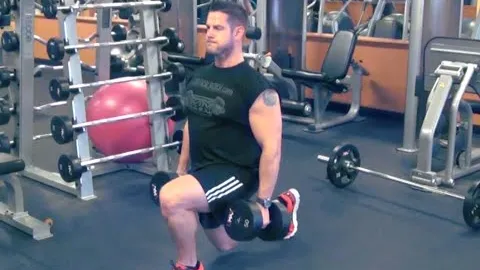


Are you looking for an effective exercise that targets your lower body muscles? Look no further than the dumbbell split squat. This compound movement is a popular choice among fitness enthusiasts due to its ability to build strength and balance in the legs, hips, and glutes. In this article, we will dive deep into the mechanics of the exercise, its benefits, and how to perform it correctly for optimal results.
The dumbbell split squat is a variation of the traditional squat exercise, with a slight modification to increase its intensity and target specific muscle groups. Here's how it's done:
Starting Position: Begin by standing tall with your feet hip-width apart and holding a dumbbell in each hand. Take a step forward with one leg, approximately two to three feet in front of the other foot. The front foot should be flat on the ground, with the knee directly above the ankle.
Descending Phase: Bend both knees and lower your body toward the ground, maintaining an upright torso and engaging your core muscles. As you descend, ensure that your front knee doesn't extend past your toes, and your back knee hovers just above the ground.
Ascending Phase: Push through your front heel and straighten your front leg, bringing yourself back to the starting position. Repeat the movement for the desired number of repetitions before switching to the other leg.
Incorporating the dumbbell split squat into your workout routine offers a range of benefits for your lower body strength and overall fitness. Let's take a closer look:
The dumbbell split squat primarily targets the quadriceps, hamstrings, gluteus maximus, and calves. By challenging these muscles, you can promote muscular development and strength, leading to improved athletic performance and functional movements in everyday life.
The split stance in the exercise requires significant balance and stability. By constantly challenging your ability to stay upright, you train not only your lower body muscles but also the small stabilizing muscles in your legs and hips. This helps enhance your overall balance and stability, reducing the risk of falls and injuries.
To maintain an upright torso throughout the exercise, your core muscles need to activate and stabilize your spine. The dumbbell split squat effectively engages your core, helping to strengthen your abdominal muscles and improve your overall core stability.
Performing split squats requires good hip, knee, and ankle flexibility. Over time, this exercise can improve the range of motion in these joints, leading to increased flexibility and reduced risk of injury during daily activities or other physical exercises.
To maximize the effectiveness of the dumbbell split squat and prevent potential injuries, it's important to perform the exercise with proper form and technique. Follow these guidelines to ensure you're doing it correctly:
Warm-up: Before diving into any exercise, it's crucial to warm up your muscles. Spend at least 5-10 minutes engaging in light cardio exercises or dynamic stretches to increase blood flow and prepare your body for the workout.
Foot Placement: Make sure your front foot is positioned firmly on the ground, with the heel and toe in line. Your back foot should be on its toes, creating a stable base for the movement.
Knee Alignment: As you descend into the squat, focus on keeping your front knee in line with your toes, preventing it from extending too far forward. This helps protect your knee joint from excess stress and potential injury.
Torso Position: Maintain an upright torso throughout the exercise. Avoid leaning too far forward or backward to ensure optimal engagement of the targeted muscles. Engaging your core muscles will help you maintain proper posture.
Breathing: Inhale as you lower your body into the squat position and exhale as you push through the front heel to return to the starting position. Proper breathing enhances your stability and provides oxygen to your muscles for optimal performance.
Weight Selection: Begin with lighter dumbbells until you have mastered the movement and built sufficient strength. Gradually increase the weight as your muscles adapt to the exercise.
The dumbbell split squat is an excellent exercise for building lower body strength, stability, and balance. By consistently incorporating it into your workout routine, you can achieve well-developed leg muscles and improved overall fitness. Remember to focus on proper form and technique, and gradually increase the intensity as your strength progresses. Incorporate this compound exercise into your fitness regimen and experience the tremendous benefits it has to offer.
If you're looking for a gym, fitness club or yoga studio, you've come to the right place.
You can find information about gyms in your area. Browse catalog of gyms and find gyms with classes which are you looking for.
On gym page you can find simple information like address, phone or website. You can find list of available classes. You can check availability of personal training or small group classes. On place page you can also see information about open hours.
You can find gyms near you with amenities, courts, studios and equipments.
Use our map to find gym at your city or district.
In Gym Navigator you can find list of exercises with movies for many body parts.
You can browse exercises catalog and find exercises the best of you.
You can also find exercises grouped into workout plans, which you can use to improve you body. Each routine show you exercises one by one and give you possibility to count you progress and count down rest time.